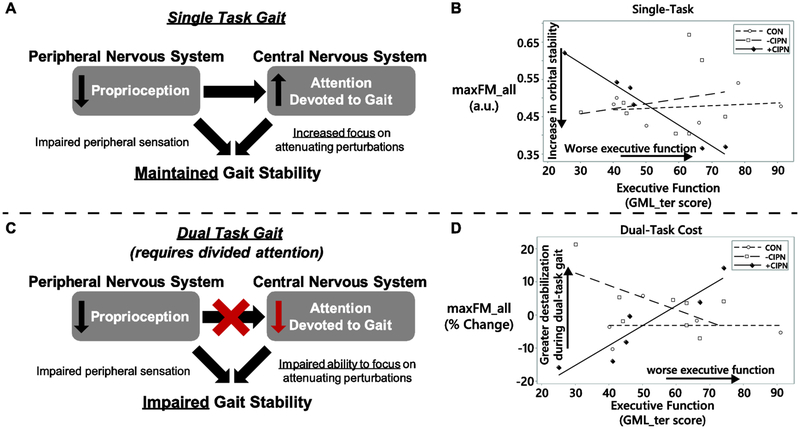Figure 3.
Proposed theoretical framework to interpret the increased dual-task cost for orbital stability in participants with CIPN sensory symptoms and poorer executive function. A. Peripheral nervous system impairments are commonly associated with CIPN. These impairments may result in a compensatory increase in cognitive attention devoted to gait to accommodate degraded afferent sensory information. Greater concentration on gait may correspond to maintained or increased attenuation of perturbations during gait, which would represent a potential increase in orbital stability. B. Experimental data showing increased orbital stability in +CIPN participants (solid markers and line; ρ = −0.94 (95% CI: −1.05, −0.77)) with worse executive function during single-task gait. C. When a simultaneous cognitive task is introduced (i.e., a dual task), the ability to compensate for degraded afferent information via increased attention is hindered. Individuals with cognitive impairments may be preferentially impacted. A consequence of the degraded afferent information along with divided attention may be a decrease in orbital stability for individuals with combined peripheral and central nervous system impairments. D. Experimental data showing increased dual-task cost (% change from single- to dual-task gait) in orbital stability for +CIPN participants with worse executive function (ρ = 0.94 (95% CI: 0.78, 1.05)). The aforementioned relationships were not detected in the CON or -CIPN groups (hollow markers and dashed lines), which is consistent with an attentionally-demanding compensatory strategy in +CIPN group being associated with the presence of sensory symptoms of CIPN. As everyday activities are performed in the presence of a number of potential concurrent demands and distractions, dual-task assessments may provide insight into physiologically-relevant demands and behavior that exist outside of the laboratory.

